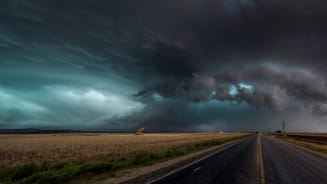Managing Risk on the Energy Transition Journey

New approaches to risk management are essential for the energy sector to seize opportunities coming from the transition to net zero.
As a growing number of countries strengthen their legislation for, and commitment to, net zero targets, the energy sector is undergoing a major transformation. Business models, operations and financing are all evolving as organisations strive to meet ongoing demand for energy while building capacity to deliver products and services required for a future economy reliant on renewables. In this article we examine key risk considerations for energy companies and highlight how global provider, PETRONAS, is addressing these risks to support stability and growth in their business network.
Balancing core business while making progress
For any energy company, the transition to delivering abundant energy with lower emissions is a balancing act. Billions of people and millions of businesses are reliant on a secure supply of energy for our global economy and society to thrive. In the move towards a world where all energy needs can be met with zero emissions, companies like PETRONAS are finding new innovative paths forward without compromising energy security for customers and end users.
“The UN talks about a just transition which ensures that in fueling the world with clean energy, efforts are being promoted in a way that is as far and inclusive as possible to everyone concerned, creating decent work opportunities and leaving no one behind. This is how we have aligned our short-term strategy to ensure no one loses out as our business adapts to meet our goal of achieving net zero by 2050.”
Norliwati Abdul Wahab
Group Chief Risk Officer, PETRONAS
Walking the line between secure energy supply and meeting emissions reduction targets requires rigor when it comes to disclosing actions and progress. Managing greenwashing risks and potential consequences for reputational issues with stakeholders is critical for any business. This is particularly the case for the energy sector where scrutiny of climate-related commitments and progress is perhaps at its highest.
“Our approach is being transparent about our commitment and the steps we’re taking for the energy transition” says Norliwati Abdul Wahab, Group Chief Risk Officer for PETRONAS. “The expectation from all our stakeholders is that we must make progress while considering all who will be impacted. We are careful to manage the reputational risk of our disclosures by making sure we have tools and measures in place to provide data that is accurate, audited and credible as well as complying to greenwashing guidelines.”
Fuelling innovation
Not only is the trade-off between traditional and renewable energy important for energy security but it is also essential for funding. For businesses like PETRONAS, returns from existing core business must be set aside to fund and grow their renewable energy aspirations. This discipline to allocate funds into new energy business makes a compelling case for lenders to secure external funding for these new ventures.
“When it comes to budgets and capital allocation, if you only consider returns and risk, a lot would go to our core business of supplying energy from existing oil and gas business,” says Norliwati. “We need to be disciplined in allocating a sizeable portion of our internal capital to fund new business growth whilst continuing to act on our commitments to net zero. This is an important element and a display of credibility and reassurance to various stakeholders and lenders that the targets we disclose are realistic and based on where investments are being made.”
Moving into uncharted territory
Growing demand for PETRONAS’ new capabilities in carbon capture and storage are also introducing new challenges and risks for the business. This space plays an essential role in keeping supply viable while reducing the emissions from energy production. “Significant upfront investment is required to keep advancing within this area despite having proven technology,” says Norliwati. “Safeguarding ongoing investment and progress requires a deep understanding of the many risks involved in moving captured carbon through the different jurisdictions, and where responsibilities lie if anything should happen to it. Then, the storage side of things also comes with many unknowns, including public acceptance of the facility and government legislation on ownership of the emissions.”
For innovations like these, it’s vital for PETRONAS to enter collaboration with oil and gas producers, shipping companies, governments and communities, and with insurers who can offer expertise and understanding of the complex cross-sector opportunities, impacts and risks involved.
For companies working at the cutting edge of innovation to secure the future for energy supply and better climate outcomes, sustaining and supportive insurance partnerships are critical. These partnerships demand continuous dialogue to secure the necessary risk transfer solutions to support these businesses on their energy transition journeys.
General Disclaimer
This document is not intended to address any specific situation or to provide legal, regulatory, financial, or other advice. While care has been taken in the production of this document, Aon does not warrant, represent or guarantee the accuracy, adequacy, completeness or fitness for any purpose of the document or any part of it and can accept no liability for any loss incurred in any way by any person who may rely on it. Any recipient shall be responsible for the use to which it puts this document. This document has been compiled using information available to us up to its date of publication and is subject to any qualifications made in the document.
Terms of Use
The contents herein may not be reproduced, reused, reprinted or redistributed without the expressed written consent of Aon, unless otherwise authorized by Aon. To use information contained herein, please write to our team.
Aon's Better Being Podcast
Our Better Being podcast series, hosted by Aon Chief Wellbeing Officer Rachel Fellowes, explores wellbeing strategies and resilience. This season we cover human sustainability, kindness in the workplace, how to measure wellbeing, managing grief and more.
Aon Insights Series Asia
Expert Views on Today's Risk Capital and Human Capital Issues
Aon Insights Series Pacific
Expert Views on Today's Risk Capital and Human Capital Issues
Aon Insights Series UK
Expert Views on Today's Risk Capital and Human Capital Issues
Construction and Infrastructure
The construction industry is under pressure from interconnected risks and notable macroeconomic developments. Learn how your organization can benefit from construction insurance and risk management.
Cyber Labs
Stay in the loop on today's most pressing cyber security matters.
Cyber Resilience
Our Cyber Resilience collection gives you access to Aon’s latest insights on the evolving landscape of cyber threats and risk mitigation measures. Reach out to our experts to discuss how to make the right decisions to strengthen your organization’s cyber resilience.
Employee Wellbeing
Our Employee Wellbeing collection gives you access to the latest insights from Aon's human capital team. You can also reach out to the team at any time for assistance with your employee wellbeing needs.
Environmental, Social and Governance Insights
Explore Aon's latest environmental social and governance (ESG) insights.
Q4 2023 Global Insurance Market Insights
Our Global Insurance Market Insights highlight insurance market trends across pricing, capacity, underwriting, limits, deductibles and coverages.
Regional Results
How do the top risks on business leaders’ minds differ by region and how can these risks be mitigated? Explore the regional results to learn more.
Human Capital Analytics
Our Human Capital Analytics collection gives you access to the latest insights from Aon's human capital team. Contact us to learn how Aon’s analytics capabilities helps organizations make better workforce decisions.
Insights for HR
Explore our hand-picked insights for human resources professionals.
Workforce
Our Workforce Collection provides access to the latest insights from Aon’s Human Capital team on topics ranging from health and benefits, retirement and talent practices. You can reach out to our team at any time to learn how we can help address emerging workforce challenges.
Mergers and Acquisitions
Our Mergers and Acquisitions (M&A) collection gives you access to the latest insights from Aon's thought leaders to help dealmakers make better decisions. Explore our latest insights and reach out to the team at any time for assistance with transaction challenges and opportunities.
Navigating Volatility
How do businesses navigate their way through new forms of volatility and make decisions that protect and grow their organizations?
Parametric Insurance
Our Parametric Insurance Collection provides ways your organization can benefit from this simple, straightforward and fast-paying risk transfer solution. Reach out to learn how we can help you make better decisions to manage your catastrophe exposures and near-term volatility.
Pay Transparency and Equity
Our Pay Transparency and Equity collection gives you access to the latest insights from Aon's human capital team on topics ranging from pay equity to diversity, equity and inclusion. Contact us to learn how we can help your organization address these issues.
Property Risk Management
Forecasters are predicting an extremely active 2024 Atlantic hurricane season. Take measures to build resilience to mitigate risk for hurricane-prone properties.
Technology
Our Technology Collection provides access to the latest insights from Aon's thought leaders on navigating the evolving risks and opportunities of technology. Reach out to the team to learn how we can help you use technology to make better decisions for the future.
Top 10 Global Risks
Trade, technology, weather and workforce stability are the central forces in today’s risk landscape.
Trade
Our Trade Collection gives you access to the latest insights from Aon's thought leaders on navigating the evolving risks and opportunities for international business. Reach out to our team to understand how to make better decisions around macro trends and why they matter to businesses.
Weather
With a changing climate, organizations in all sectors will need to protect their people and physical assets, reduce their carbon footprint, and invest in new solutions to thrive. Our Weather Collection provides you with critical insights to be prepared.
Workforce Resilience
Our Workforce Resilience collection gives you access to the latest insights from Aon's Human Capital team. You can reach out to the team at any time for questions about how we can assess gaps and help build a more resilience workforce.
Explore more from our Aon Insights Series:
-

Article
Energy Transition Investments: How Advanced Analytics Can Empower Organizations
Advanced analytics can empower organizations with deeper insights into the risks and opportunities surrounding renewables, while also supporting energy transition investment.
-

Article
Insurance Plays a Key Role in Transitioning to a Low Carbon Future
The insurance industry can help the economy transition to alternative energy sources and mitigate the impacts of climate change.
-

Article
8 Focus Areas for the Renewable Energy Sector
As more companies seek to reduce their carbon footprint, the renewable energy sector continues to grow, presenting both opportunities and red flags for organizations with renewable energy growth plans.
-

Podcast
A game of hot potato - risk of ever-growing weather extremes
In this episode, Aon Australia’s Chief Commercial Officer, Stephen Trickey, and Climate Risk Advisory APAC Analytics Lead, Tom Mortlock speak about two top weather trends that business leaders need to know about now.



















































































































































